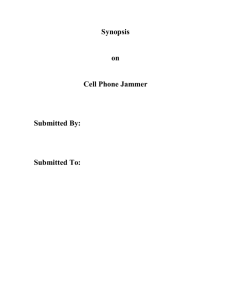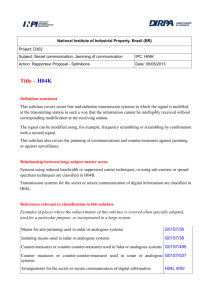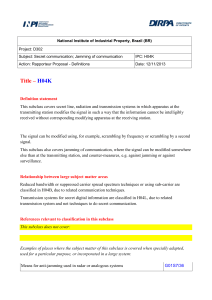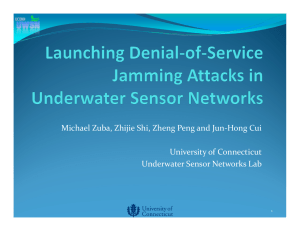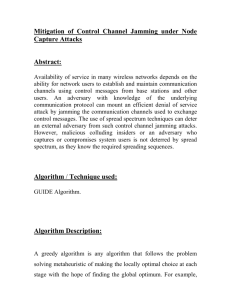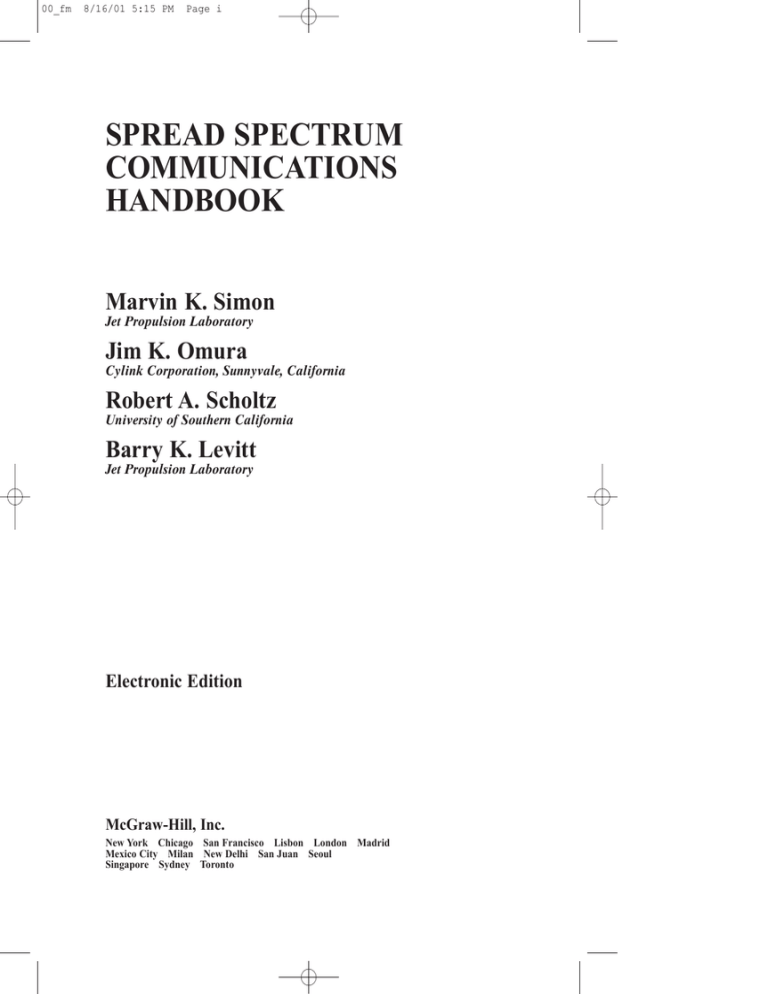
00_fm
8/16/01 5:15 PM
Page i
SPREAD SPECTRUM
COMMUNICATIONS
HANDBOOK
Marvin K. Simon
Jet Propulsion Laboratory
Jim K. Omura
Cylink Corporation, Sunnyvale, California
Robert A. Scholtz
University of Southern California
Barry K. Levitt
Jet Propulsion Laboratory
Electronic Edition
McGraw-Hill, Inc.
New York Chicago San Francisco Lisbon London
Mexico City Milan New Delhi San Juan Seoul
Singapore Sydney Toronto
Madrid
00_fm
8/16/01 5:15 PM
Page ii
Copyright © 2002, 1994 by The McGraw-Hill Companies, Inc. All
rights reserved. Printed in the United States of America. Except as
permitted under the United States Copyright Act of 1976, no part of
this publication may be reproduced or distributed in any form or by
any means, or stored in a data base or retrieval system, without the
prior written permission of the publisher.
The first edition was published in three volumes by Computer Science
press in 1985 under the title Spread Spectrum Communications.
1 2 3 4 5 6 7 8 9 0 DOC/DOC 0 9 8 7 6 5 4 3 2 1
P/N 138225-9
PART OF
ISBN 0-07-138215-1
The sponsoring editor for this book was Stephen S. Chapman, the editing
supervisor was David E. Fogarty, and the production supervisor was
Sherri Souffrance. It was set in Times Roman by MacAllister
Publishing Services, LLC
Printed and bound by R. R. Donnelley & Sons Company.
This book is printed on recycled, acid-free paper containing
a minimum of 50% recycled, de-inked fiber.
Information contained in this work has been obtained by
McGraw-Hill, Inc., from sources believed to be reliable.
However, neither McGraw-Hill nor its authors guarantee the
accuracy or completeness of any information published herein,
and neither McGraw-Hill nor its authors shall be responsible for
any errors, omissions, or damages arising out of use of this
information. This work is published with the understanding that
McGraw-Hill and its authors are supplying information but are
not attempting to render engineering or other professional services. If such services are required, the assistance of an appropriate professional should be sought.
00_fm
8/16/01 5:15 PM
Page iii
CONTENTS
Preface
Preface to First Edition
PART 1
xv
xvi
INTRODUCTION TO SPREAD-SPECTRUM
COMMUNICATIONS
Chapter 1 A Spread-Spectrum Overview
1.1 A Basis for a Jamming Game
1.2 Energy Allocation Strategies
1.3 Spread-Spectrum System Configurations and Components
1.4 Energy Gain Calculations for Typical Systems
1.5 The Advantages of Spectrum Spreading
1.5.1 Low Probability of Intercept (LPI)
1.5.2 Independent Interference Rejection and
Multiple-Access Operation
1.5.3 High-Resolution Time-of-Arrival (TOA)
Measurements
1.6 Design Issues
1.7 References
1.7.1 Books on Communication Theory
1.7.2 Books on Resolution and Ambiguity Functions
1.7.3 Recent Books and Proceedings on Spread-Spectrum
Communications
1.7.4 Spread-Spectrum Tutorials and General
Interest Papers
25
29
37
38
38
39
39
39
Chapter 2
2.1
The Historical Origins of Spread-Spectrum
Communications
Emerging Concepts
2.1.1 Radar Innovations
2.1.2 Developments in Communication Theory
2.1.3 Correlator Mechanization
2.1.4 Protected Communications
2.1.5 Remote Control and Missile Guidance
3
3
6
9
17
20
20
iii
41
42
42
45
47
48
58
00_fm
8/16/01 5:15 PM
Page iv
iv
Contents
2.2
2.3
2.4
2.5
Early Spread-Spectrum Systems
2.2.1 WHYN
2.2.2 A Note on CYTAC
2.2.3 Hush-Up
2.2.4 BLADES
2.2.5 Noise Wheels
2.2.6 The Hartwell Connection
2.2.7 NOMAC
2.2.8 F9C-A/Rake
2.2.9 A Note on PPM
2.2.10 CODORAC
2.2.11 M-Sequence Genesis
2.2.12 AN/ARC-50 Development at Magnavox
Branches on the SS Tree
2.3.1 Spread-Spectrum Radar
2.3.2 Other Early Spread-Spectrum
Communication Systems
2.3.3 Spread-Spectrum Developments Outside
the United States
A Viewpoint
References
Chapter 3 Basic Concepts and System Models
3.1 Design Approach for Anti-Jam Systems
3.2 Models and Fundamental Parameters
3.3 Jammer Waveforms
3.3.1 Broadband and Partial-Band Noise Jammers
3.3.2 CW and Multitone Jammers
3.3.3 Pulse Jammer
3.3.4 Arbitrary Jammer Power Distributions
3.3.5 Repeat-Back Jammers
3.4 Uncoded Direct-Sequence Spread Binary Phase-Shift-Keying
3.4.1 Constant Power Broadband Noise Jammer
3.4.2 Pulse Jammer
3.5 Coded Direct-Sequence Spread Binary Phase-Shift-Keying
3.5.1 Interleaver and Deinterleaver
3.5.2 Unknown Channel State
3.5.2.1 Soft Decision Decoder
3.5.2.2 Hard Decision Decoder
3.5.3 Known Channel State
3.5.3.1 Soft Decision Decoder
3.5.3.2 Hard Decision Decoder
3.6 Uncoded Frequency-Hopped Binary
Frequency-Shift-Keying
65
65
71
71
73
78
84
87
90
100
100
106
108
111
111
112
121
123
125
137
137
139
141
141
143
143
143
144
144
147
150
153
158
159
160
162
165
166
168
169
00_fm
8/16/01 5:15 PM
Page v
Contents
v
3.6.1 Constant Power Broadband Noise Jammer
3.6.2 Partial-Band Noise Jammer
3.6.3 Multitone Jammer
3.7 Coded Frequency-Hopped Binary Frequency-Shift-Keying
3.8 Interleaver/Hop Rate Tradeoff
3.9 Receiver Noise Floor
3.10 Discussion
3.11 References
Appendix 3A: Interleaving and Deinterleaving
172
174
176
178
180
180
183
183
184
Chapter 4 General Analysis of Anti-Jam Communication Systems
4.1 System Model
4.2 Coded Bit Error Rate Bound
4.3 Cutoff Rates
4.4 Conventional Coherent BPSK
4.5 DS/BPSK and Pulse Jamming
4.6 Translation of Coded Error Bounds
4.7 Conventional Non-Coherent MFSK
4.7.1 Uncoded
4.7.2 Coded
4.8 FH/MFSK and Partial-Band Jamming
4.9 Diversity for FH/MFSK
4.10 Concatenation of Codes
4.10.1 Binary Super Channel
4.10.2 M-ary Super Channel
4.10.3 Reed-Solomon Outer Codes
4.11 Summary of Bit Error Bounds
4.11.1 DS/BPSK with Pulse Jamming
4.11.2 FH/MFSK with Partial-Band Noise Jamming
4.11.3 Coding Functions
4.12 References
Appendix 4A: Chernoff Bound
Appendix 4B: Factor of One-Half in Error Bounds
Appendix 4C: Reed-Solomon Code Performance
189
190
194
196
198
204
205
208
208
213
217
227
235
235
238
238
246
246
247
249
249
250
251
260
Chapter 5 Pseudonoise Generators
5.1 The Storage/Generation Problem
5.2 Linear Recursions
5.2.1 Fibonacci Generators
5.2.2 Formal Power Series and Characteristic Polynomials
5.2.3 Galois Generators
5.2.4 State Space Viewpoint
5.2.5 Determination of Linear Recursions from
Sequence Segments
264
264
271
271
273
275
278
280
00_fm
8/16/01 5:15 PM
Page vi
vi
Contents
5.3
Memory-Efficient Linear Generators
5.3.1 Partial Fraction Decompositions
5.3.2 Maximization of Period for a Fixed Memory Size
5.3.3 Repeated Factors in the Characteristic Polynomial
5.3.4 M-Sequences
5.4 Statistical Properties of M-Sequences
5.4.1 Event Counts
5.4.2 The Shift-and-Add Property
5.4.3 Hamming Distance Properties of Derived
Real-Integer Sequences
5.4.4 Correlation Properties of Derived Complex
Roots-of-Unity Sequences
5.5 Galois Field Connections
5.5.1 Extension Field Construction
5.5.2 The LFSR as a Galois Field Multiplier
5.5.3 Determining the Period of Memory Cell Outputs
5.5.4 The Trace Representation of M-Sequences
5.5.5 A Correlation Computation
5.5.6 Decimations of Sequences
5.6 Non-Linear Feed-Forward Logic
5.6.1 A Powers-of-a Representation Theorem
5.6.2 Key’s Bound on Linear Span
5.6.3 Difference Set Designs
5.6.4 GMW Sequences
5.7 Direct-Sequence Multiple-Access Designs
5.7.1 A Design Criterion
5.7.2 Welch’s Inner Product Bound
5.7.3 Cross-correlation of Binary M-Sequences
5.7.4 Linear Designs
5.7.5 A Transform-Domain Design Philosophy
5.7.6 Bent Sequences
5.8 Frequency-Hopping Multiple-Access Designs
5.8.1 Design Criteria
5.8.2 A Bound on Hamming Distance
5.8.3 An FHMA Design Employing an M-Sequence
Generator
5.8.4 Reed-Solomon Sequences
5.9 A Look at the Literature
5.10 References
Appendix 5A: Finite Field Arithmetic
Appendix 5B: Factorizations of 2n —1 and Selected
Primitive Polynomials
281
281
283
284
285
286
287
288
289
291
297
297
298
299
301
304
305
307
307
311
315
317
326
326
327
329
334
340
344
352
352
353
354
355
360
362
367
398
00_fm
8/16/01 5:15 PM
Page vii
Contents
PART 2
vii
CLASSICAL SPREAD-SPECTRUM
COMMUNICATIONS
Chapter 1 Coherent Direct Sequence Systems
1.1 Direct-Sequence Spread Coherent Binary Phase-Shift
Keying
1.2 Uncoded Bit Error Probability for Arbitrary Jammer
Waveforms
1.2.1 Chernoff Bound
1.2.2 Gaussian Assumptions
1.3 Uncoded Bit Error Probability for Specific Jammer
Waveforms
1.3.1 CW Jammer
1.3.2 Random Jammer
1.4 Pulse Jamming
1.4.1 Arbitrary Time Distribution
1.4.2 Worst Case Jammer
1.5 Standard Codes and Cutoff Rates
1.5.1 The Additive White Gaussian Noise Channel
1.5.2 Jamming Channels
1.6 Slow Frequency Non-Selective Fading Channels
1.6.1 Continuous Jammer with No Coding
1.6.2 Continuous Jammer with Coding—No Fading
Estimate
1.6.3 Continuous Jammer with Coding—Fading
Estimate
1.6.4 Pulse Jammer with No Coding
1.7 Slow Fading Multipath Channels
1.8 Other Coding Metrics for Pulse Jamming
1.9 Discussion
1.10 References
Chapter 2 Non-Coherent Frequency-Hopped Systems
2.1 Broadband Noise Jamming
2.2 Worst Case Jamming
2.2.1 Partial-Band Noise Jamming
2.2.2 Multitone Jamming
2.2.2.1 Random Jamming Tone Phase
2.2.2.2 Band Multitone Jamming
2.2.2.3 Independent Multitone Jamming
2.3 Coding Countermeasures
2.3.1 Time Diversity
2.3.1.1 Partial-Band Noise Jamming
2.3.1.2 Band Multitone Jamming
2.3.1.3 Independent Multitone Jamming
405
407
409
410
411
412
414
416
418
418
420
422
422
424
428
428
430
436
441
442
453
460
462
464
471
475
475
480
483
484
493
497
497
500
512
535
00_fm
8/16/01 5:15 PM
Page viii
viii
Contents
2.3.1.4 Time Diversity Overview
Coding Without Diversity
2.3.2.1 Convolutional Codes
2.3.2.2 Reed-Solomon Codes
2.3.2.3 Concatenated Codes
2.3.3 Coding With Diversity
2.3.3.1 Optimum Code Rates
2.4 Slow Fading Uniform Channels
2.4.1 Broadband Jamming—No Diversity
2.4.2 Broadband Jamming—Diversity and Coding
2.4.3 Partial-Band Jamming
2.5 Worst Noise Jammer Distribution—Slow Fading
Uniform Channel
2.5.1 Uncoded
2.5.2 Diversity and Coding
2.6 Worst Noise Jammer Distribution—Slow Fading
Nonuniform Channel
2.6.1 Uncoded
2.6.2 Diversity and Coding
2.7 Other Coding Metrics
2.7.1 Energy Quantizer
2.7.2 Hard Decision with One Bit Quality Measure
2.7.3 List Metric
2.7.4 Metrics for Binary Codes
2.8 References
Appendix 2A: Justification of Factor of 1/2 for FH/MFSK Signals
with Diversity in Partial-Band Noise
Appendix 2B: Combinatorial Computation for n 1 Band
Multitone Jamming
2.3.2
PART 3
540
546
547
562
565
567
593
600
602
604
612
615
615
619
622
623
626
630
633
636
641
652
660
662
664
OTHER FREQUENCY-HOPPED SYSTEMS
Chapter 1 Coherent Modulation Techniques
1.1 Performance of FH/QPSK in the Presence of PartialBand Multitone Jamming
1.2 Performance of FH/QASK in the Presence of PartialBand Multitone Jamming
1.3 Performance of FH/QPSK in the Presence of PartialBand Noise Jamming
1.4 Performance of FH/QASK in the Presence of PartialBand Noise Jamming
1.5 Performance of FH/PN/QPSK in the Presence of
Partial-Band Multitone Jamming
1.6 Performance of FH/PN/QASK in the Presence of
Partial-Band Multitone Jamming
669
670
680
687
690
693
698
00_fm
8/16/01 5:15 PM
Page ix
Contents
ix
1.7
Performance of FH/QPR in the Presence of PartialBand Multitone Jamming
1.8 Performance of FH/QPR in the Presence of PartialBand Multitone Jamming
1.9 Summary and Conclusions
1.10 References
Chapter 2 Differentially Coherent Modulation Techniques
2.1 Performance of FH/MDPSK in the Presence of PartialBand Multitone Jamming
2.1.1 Evaluation of Q2pn/m
2.2 Performance of FH/MDPSK in the Presence of PartialBand Noise Jamming
2.3 Performance of DQASK in the Presence of Additive
White Gaussian Noise
2.3.1 Characterization of the Transmitted Signal
2.3.2 Receiver Characterization and Performance
2.4 Performance of FH/DQASK in the Presence of
Partial-Band Multitone Jamming
2.5 Performance of FH/DQASK in the Presence of
Partial-Band Noise Jamming
2.6 References
PART 4
699
710
713
713
715
716
719
728
731
31
732
739
748
749
SYNCHRONIZATION OF SPREAD-SPECTRUM
SYSTEMS
Chapter 1 Pseudonoise Acquisition in Direct Sequence Receivers
1.1 Historical Survey
1.2 The Single Dwell Serial PN Acquisition System
1.2.1 Markov Chain Acquisition Model
1.2.2 Single Dwell Acquisition Time Performance in the
Absence of Code Doppler
1.2.3 Single Dwell Acquisition Time Performance in the
Presence of Code Doppler and Doppler Rate
1.2.4 Evaluation of Detection Probability PD and False
Alarm Probability PFA in Terms of PN Acquisition
System Parameters
1.2.5 Effective Probability of Detection and Timing
Misalignment
1.2.6 Modulation Distortion Effects
1.2.7 Reduction in Noise Spectral Density Caused by
PN Despreading
1.2.8 Code Doppler and Its Derivative
1.2.9 Probability of Acquisition for the Single
Dwell System
753
753
765
767
770
777
781
785
786
786
787
789
00_fm
8/16/01 5:15 PM
Page x
x
Contents
1.3
The Multiple Dwell Serial PN Acquisition System
1.3.1 Markov Chain Acquisition Model
1.3.2 Multiple Dwell Acquisition Time Performance
1.4 A Unified Approach to Serial Search Acquisition with
Fixed Dwell Times
1.4.1 The Flow Graph Technique
1.5 Rapid Acquisition Using Matched Filter Techniques
1.5.1 Markov Chain Acquisition Model and Acquisition
Time Performance
1.5.2 Evaluation of Detection and False Alarm
Probabilities for Correlation and Coincidence
Detectors
1.5.2.1 Exact Results
1.5.2.2 Approximate Results
1.5.2.3 Acquisition Time Performance
1.6 PN Sync Search Procedures and Sweep Strategies for a
Non-Uniformly Distributed Signal Location
1.6.1 An Example—Single Dwell Serial Acquisition with
an Optimized Expanding Window Search
1.6.2 Application of the Circular State Diagram
Approach
1.7 PN Synchronization Using Sequential Detection
1.7.1 A Brief Review of Sequential Hypothesis Testing
as Applied to the Non-Coherent Detection of
a Sine Wave in Gaussian Noise
1.7.2 The Biased Square-Law Sequential Detector
1.7.3 Probability of False Alarm and Average Test
Duration in the Absence of Signal
1.7.4 Simulation Results
1.8 Search/Lock Strategies
1.8.1 Mean and Variance of the Acquisition Time
1.8.1.1 Evaluation of Probability Lock
1.8.1.2 Evaluation of Mean Dwell Time
1.8.2 Another Search/Lock Strategy
1.9 Further Discussion
1.10 References
Chapter 2 Pseudonoise Tracking in Direct Sequence Receivers
2.1 The Delay-Locked Loop
2.1.1 Mathematical Loop Model and Equation of
Operation
2.1.2 Statistical Characterization of the Equivalent
Additive Noise
2.1.3 Linear Analysis of DLL Tracking Performance
2.2 The Tau-Dither Loop
794
798
801
811
811
817
824
827
829
831
833
834
838
843
860
864
867
868
877
885
887
890
891
896
898
899
903
904
904
909
911
915
00_fm
8/16/01 5:15 PM
Page xi
Contents
xi
2.2.1
Mathematical Loop Model and equation of
Operation
2.2.2 Statistical Characterization of the Equivalent
Additive Noise
2.2.3 Linear Analysis of TDL Tracking Performance
2.3 Acquisition (Transient) Behavior of the DLL and TDL
2.4 Mean Time to Loss-of-Lock for the DLL and TDL
2.5 The Double Dither Loop
2.6 The Product of Sum and Difference DLL
2.7 The Modified Code Tracking Loop
2.8 The Complex Sums Loop (A Phase-Sensing DLL)
2.9 Quadriphase PN Tracking
2.10 Further Discussion
2.11 References
920
922
928
933
935
937
941
948
949
952
956
Chapter 3
3.1
3.2
3.3
Time and Frequency Synchronization of
Frequency-Hopped Receivers
FH Acquisition Techniques
3.1.1 Serial Search Techniques with Active Correlation
3.1.2 Serial Search Techniques with Passive Correlation
3.1.3 Other FH Acquisition Techniques
Time Synchronization of Non-Coherent FH/MFSK
Systems
3.2.1 The Case of Full-Band Noise jamming
3.2.1.1 Signal Model and Spectral Computations
3.2.1.2 Results of Large Nh
3.2.2 The Case of Partial-Band Noise Jamming
3.2.2.1 Results of Large Nh
3.2.3 The Effects of Time Synchronization Error on
FH/MFSK Error Probability Performance
3.2.3.1 Conditional Error Probability
Performance—No Diversity
3.2.3.2 Conditional Error Probability
Performance—m-Diversity with
Non-Coherent Combining
3.2.3.3 Average Error Probability Performance
in the Presence of Time Synchronization
Error Estimation
Frequency Synchronization of Non-Coherent FH/MFSK
Systems
3.3.1 The Case of Full-Band Noise Jamming
3.3.1.1 Signal Model and Spectral Computations
3.3.2 The Case of Partial-Band Noise Jamming
3.3.3 The Effects of Frequency Synchronization
Error on FH/MFSK Error Probability Performance
916
958
959
959
983
985
989
992
992
997
999
1000
1001
1002
1006
1009
1011
1013
1013
1017
1017
00_fm
8/16/01 5:15 PM
Page xii
xii
Contents
3.3.3.1 Average Error Probability Performance
in the Presence of Frequency
Synchronization Error Estimation
3.4 References
Appendix 3A: To Prove That a Frequency Estimator Based
upon Adjacent Spectral Estimates Taken at
Integer Multiples of 1/T Cannot be Unbiased
PART 5
1022
1026
SPECIAL TOPICS
Chapter 1 Low Probability of Intercept Communications
1.1 Signal Modulation Forms
1.2 Interception Detectors
1.2.1 Ideal and Realizable Detectors
1.2.1.1 Detectability Criteria
1.2.1.2 Maximum or Bounding Performance of
Fundamental Detector Types
(1) Wideband Energy Detector
(Radiometer)
(2) Optimum Multichannel FH
Pulse-Matched Energy Detector
(3) Filter Bank Combiner (FBC) Detector
(4) Partial-band Filter Bank Combiner
(PB-FBC)
1.2.1.3 Signal Structures and Modulation
Considerations
1.2.2 Non-idealistic Detector Performance
1.2.2.1 The Problem of Time Synchronization
(1) Wideband Detector with Overlapping
I & Ds Each of Duration Equal to
That of the Message
(2) Wideband Detector with Single
(Non-overlapping) I & D of
Duration Equal to Half of the
Message Duration
(3) Wideband Detector with a
Continuous Integration PostDetection RC Filter
(4) Filter Bank Combiner with
Overlapping I & Ds Each of Hop
Interval Duration
1.2.2.2 The Problem of Frequency
Synchronization
(1) Doppler Effects
(2) Performance of the FBC with
Frequency Error
1033
1035
1036
1037
1037
1037
1038
1040
1045
1050
1055
1059
1059
1059
1063
1064
1066
1070
1070
1070
00_fm
8/16/01 5:15 PM
Page xiii
Contents
xiii
1.2.3
Detector Implementation
1.2.3.1 Basic Configurations
(1) Wideband Single-Channel
Detectors
(2) Channelized Detectors
1.2.3.2 Other Possible Feature Detector
Configurations
1.3 Performance and Strategies Assessment
1.3.1 Communicator Modulation and Intercept
Detectors
1.3.2 Anti-Jam Measures
1.3.3 Optimum LPI Modulation/Coding Conditions
1.4 Further Discussion
1.5 References
Appendix 1A: Conditions for Viable Multichannel Detector
Performance
Chapter 2 Multiple Access
2.1 Networks
2.1.1 Decentralized (Point-to-Point) Networks
2.1.2 Centralized (Multipoint-to-Point) Networks
2.2 Summary of Multiple Access Techniques
2.3 Spread-Spectrum Multiple Access with DS/BPSK
Waveforms
2.3.1 Point-to-Point
2.3.2 Conventional Multipoint-to-Point
2.3.3 Optimum Multipoint-to-Point
2.4 Spread-Spectrum Multiple Access with FH/MFSK
Waveforms
2.4.1 Point-to-Point
2.4.2 Conventional Multipoint-to-Point
2.4.3 Optimum Multipoint-to-Point
2.5 Discussion
2.6 References
Chapter 3 Commercial Applications
3.1 Key Events in the Commercial Market
3.2 The United States FCC Part 15 Rules
3.2.1 Indoor Applications
3.2.2 Outdoor Applications
3.2.3 Direct Sequence Versus Frequency Hopping
3.2.3.1 Conversion of Narrowband Radios
3.2.3.2 Cost of Development and Products
3.2.3.3 Performance
3.2.4 Multipath and Diversity
3.2.5 Results of The Part 15 Rule
1074
1074
1074
1076
1077
1083
1083
1087
1089
1089
1092
1093
1096
1099
1099
1103
1105
1110
1110
1113
1116
1123
1124
1136
1142
1148
1148
1158
1160
1160
1161
1162
1162
1163
1163
1163
1165
1166
00_fm
8/16/01 5:15 PM
Page xiv
xiv
3.3
The Digital Cellular CDMA Standard
3.3.1 Overview of the CDMA Digital Cellular
System (IS-95)
3.3.2 Comparison of IS-95, IS-54, and GSM
3.4 A New Paradigm for Designing Radio Networks
3.5 The Potential Capacity of Direct Sequence Spread
Spectrum CDMA in High-Density Networks
3.5.1 Data Versus Voice Applications
3.5.2 Power Control
3.5.3 Time Synchronization and Orthogonal Codes
3.5.4 The Outbound Channel
3.5.5 Frequency Reuse and Antenna Sectorization
3.5.6 Narrowbeam and Delay-line Antennas
3.6 Spread Spectrum CDMA for PCS/PCN
3.6.1 Binary Orthogonal Codes
3.6.2 S-CDMA Equivalent to Bit-Level TDMA
3.6.3 A High-Density Voice PCS System
3.6.3.1 Bit-Error Probabilities
3.6.3.2 Computer Simulations
3.6.3.3 Other System Issues
3.6.3.4 Comparison with DECT
3.7 Higher Capacity Optional Receivers
3.8 Summary
3.9 References
Appendix 3A: Multipath and Diversity
Appendix 3B: Error Bounds for Interference-Limited Channels
Index
Contents
1169
1170
1172
1173
1176
1179
1179
1179
1180
1181
1181
1182
1183
1183
1186
1188
1191
1192
1193
1194
1195
1196
1198
1208
1215
00_fm
8/16/01 5:15 PM
Page xv
PREFACE
In the nine years since the publication of the first edition of Spread
Spectrum Communications, the world’s political situation has changed considerably. The U.S. Department of Defense has reduced its support for the
development of new communication systems as well as their acquisition.
One might question the need for a second edition of a book written about
robust techniques for anti-jamming (AJ) and low-probability-of-intercept
(LPI) communications.
However, while it is already painfully clear that the close of the Cold War
has not ended warfare, the past decade has also ushered in a new era of
mobile communications. The qualities that make spread-spectrum techniques useful in military communications—fine time-resolution, low powerdensity, privacy, and a high immunity to interference—are also extremely
desirable in today’s mobile communications systems. Encouraged by enlightened FCC actions, spread-spectrum technology is being transferred from the
Department of Defense to the arena of commercial mobile cellular communications. The emerging markets for spread-spectrum systems have the
potential to dwarf those of the past.
Are the design techniques for military communication systems truly
applicable to the commercial environment? Does yesteryear’s jammer have
anything to teach us about managing multiple-user noise in a spread-spectrum multiple-access radio network? The answer—an unqualified “yes”—is
attested to by the successes of companies that are penetrating the commercial marketplace with spread-spectrum products.
This revised edition contains new material on the emerging commercial
applications of spread-spectrum techniques as well as minor modifications
to the book’s original fourteen chapters. We believe that since it is based on
sound engineering principles and is not bound to a particular implementation technology, it will retain its usefulness for the foreseeable future.
Marvin K. Simon
Jim K. Omura
Robert A. Scholtz
Barry K. Levitt
xv
00_fm
8/16/01 5:15 PM
Page xvi
PREFACE TO FIRST EDITION
Not more than a decade ago, the discipline of spread-spectrum (SS) communications was primarily cloaked in secrecy. Indeed, most of the information available on the subject at that time could be found only in documents
of a classified nature.
Today the picture is noticeably changed. The open literature abounds with
publications on SS communications, special issues of the IEEE Transactions
on Communications have been devoted to the subject, and the formation of
an annual conference on military communications, MILCOM, now offers a
public forum for presentation of unclassified (as well as classified) papers
dealing with SS applications in military systems. On a less formal note, many
tutorial and survey papers have recently appeared in the open literature, and
presentations on a similar level have taken place at major communications
conferences. Finally, as further evidence we cite the publication of several
books dealing either with SS communications directly or as part of the more
general electronic countermeasures (ECM) and electronic counter-counter
measures (ECCM) problem. References to all these forms of public documentation are given in Section 1.7 of Chapter 1, Part 1.
The reasons for this proliferation can be traced to many sources. While it
is undoubtedly true that the primary application of SS communications still
lies in the development of enemy jam-resistant communication systems for
the military, largely within the confines of classified programs, the emergence
of other applications, in which both the military and civilian sectors are
involved, as playing a role of ever-increasing importance. For example, to
minimize mutual interference, the flux density of transmissions from radio
transmitters must often be maintained at acceptably low radiation levels. A
convenient way to meet these requirements is to spread the power spectrum
of the signal before transmission and despread it after reception—the nonhostile equivalent of the military low-probability-of-intercept (LPI) signal
design.
Another instance in which SS techniques are particularly useful in a nonanti-jam application is in multiple-access communications in which many
users share a single communication channel. The assignment of a unique SS
sequence to each user allows him or her to transmit simultaneously over the
common channel with a minimum of mutual interference, simplifying the
network control requirements.
xvi
00_fm
8/16/01 5:15 PM
Page xvii
Preface to First Edition
xvii
Extremely accurate positioning can be computed by using signals from
several satellites in synchronous and asynchronous orbits. Satellites transmitting pseudorandom noise sequences modulated onto the transmitted carrier signal provide the means for accomplishing the required range and
distance determination at any point on the earth.
Finally, SS techniques can improve the reliability of transmission in frequency-selective fading and multipath environments. Spreading the bandwidth of the transmitted signal over a wide range of frequencies reduces its
vulnerability to interference and often provides some diversity gain at the
receiver.
At the heart of all these potential applications lies the increasing use of
digital forms of modulation for transmitting information, driven by the
tremendous advances made over the last decade in microelectronics. This
trend no doubt will continue, and thus it should not be surprising that more
and more applications for spread-spectrum techniques will continue to surface. Indeed, the state-of-the-art is advancing so rapidly (e.g., witness the
recent improvements in frequency synthesizers boosting frequency hop
rates from the Khops/sec to the Mhops/sec ranges over SS bandwidths in
excess of a GHz) that today’s primarily theoretical concepts will be realized
tomorrow.
Unclassified research and developments in spread-spectrum communications have arrived at a point of maturity necessary to justify a textbook on
SS communications that goes far beyond the level of those available on
today’s market. Such is the purpose of Spread Spectrum Communications.
Contained within the fourteen chapters of its three volumes is an in-depth
treatment of SS communications that should appeal to the specialist already
familiar with the subject as well as the neophyte with little or no background
in the area. The book is organized into five parts, within which the various
chapters are for the most part self-contained. The exception is Chapter 3,
Part 1, which deals with basic concepts and system models and serves as a
basis for many of the other chapters that follow. As would be expected, the
more traditional portions of the subject are treated in the first two parts,
while the latter three parts deal with more specialized aspects. The authors
envision that an introductory one-semester course in SS communications
taught at a graduate level in a university might cover all or parts of Chapters
1, 3, 4, 5 of Part 1, Chapters 1 and 2 of Part 2, and Chapters 1 and 2 of Part 4.
In composing the technical material presented in Spread Spectrum
Communications, the authors have intentionally avoided referring by name
to specific modern SS systems that employ techniques such as those discussed in many of the chapters. Such a choice was motivated by the desire
to offer a unified approach to the subject that stresses fundamental principles rather than specific applications. Nevertheless, the reader should feel
confident that the broad experience of the four authors ensures that the
material is practical as well as academically inspiring.
In writing a book of this magnitude, we acknowledge many whose efforts
should not go unnoticed. Credit is due to Paul Green for originally suggesting
00_fm
8/16/01 5:15 PM
xviii
Page xviii
Preface to First Edition
the research that uncovered the material in Chapter 2, Part 1, and to Bob
Price for the tireless sleuthing which led to much of the remarkable information presented there. Chapter 5, Part 1 benefited significantly from the
comments of Lloyd Welch, whose innovative research is responsible for some
of the elegant sequence designs presented there. Per Kullstam helped clarify the material on DS/BPSK analysis in Chapter 1, Part 2. Paul Crepeau contributed substantially to the work on list detectors. Last but by no means
least, the authors would like to thank James Springett, Gaylord Huth, and
Richard Iwasaki for their contributions to much of the material presented
in Chapter 4, Part 5.
Several colleagues of the authors have aided in the production of a useful book by virtue of critical reading and/or proofing. In this regard, the
efforts of Paul Crepeau, Larry Hatch, Vijay Kumar, Sang Moon, Wei-Chung
Peng, and Reginaldo Polazzo, Jr. are greatly appreciated.
It is often said that a book cannot be judged by its cover. The authors of
Spread Spectrum Communications are proud to take exception to this commonly quoted cliche. For the permission to use the historically significant
noise-wheel cover design (see Chapter 2, Part 1, Section 2.2.5), we gratefully
acknowledge the International Telephone and Telegraph Corp.
Marvin K. Simon
Jim K. Omura
Robert A. Scholtz
Barry K. Levitt

